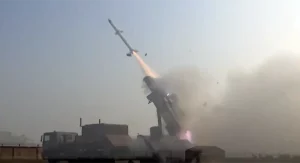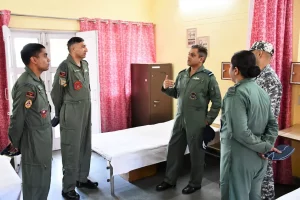Defence Minister Rajnath Singh holds talks with US counterpart Mark Esper over India-China face-off
- Defence Minister Rajnath Singh spoke to his American counterpart Mark Esper over the telephone on Tuesday, during which the ongoing tensions at the Line of Actual Control (LAC) between India and China are expected to come up for discussion.
- Meanwhile, the third round of Corps Commander-level talks between India and China to discuss and diffuse the tension over the ongoing dispute along the LAC in Eastern Ladakh was held at 10:30 am in Chushul, Leh yesterday.
China Intrudes 423 Metres into Indian Territory in Galwan: Satellite Pics
- High resolution satellite images indicate that as of June 25, there were 16 Chinese tents and tarpaulins, one large shelter and at least 14 vehicles in this 423 metre stretch of Indian territory.
- The Chinese claim of 1960 including the exact latitude and longitude of what Beijing believed to be its boundary in this area has been spelt out in ”Report of the Officials of the Governments of India and the People’s Republic of China on the Boundary Question.”
- The document, published by the Ministry of External Affairs in 1960-1961, lists Indian questions and the Chinese responses in talks held between the two sides. In response to an Indian question on the height of some peaks and location of specific passes, the Chinese side lists a series of specific coordinates of their claim, including in the Galwan river area. According to this, ”after the alignment passed over the two peaks, it went south along the mountain ridge, where it crossed the Galwan river at Long. 78° 13′ E, Lat. 34° 46′ N.”
- A simple search of these coordinates on Google Earth Pro indicates the precise location of this line in the Galwan Valley. The areas to the immediate north of these coordinates should be Indian territory. Instead, as the satellite pictures indicate, there is a clear incursion here. The measurement tool on Google Earth Pro indicates that the Chinese are in occupation of 423 metres of Indian territory along the Galwan riverbank to the north of its own Claim Line.
- ”They are taking a very maximalist position,” says former Foreign Secretary Nirupama Rao who was privy to boundary talks between India and China during her tenure. ”They are going far beyond their definition of their claim line as conveyed to us in the official talks.”
- In his address to the nation recently on his monthly radio show, “Mann Ki Baat”, Prime Minister Narendra Modi said, without naming China, “Those who cast an evil eye on Indian soil in Ladakh have got a befitting response. India honours the spirit of friendship. She is also capable of giving an appropriate response to any adversary, without shying away.” On June 27, Vikram Mistry, India’s Ambassador to Beijing said, “The resolution of this issue is quite straight forward from our perspective. The Chinese side needs to stop creating obstruction and hindrances in the normal patrolling patterns of the Indian troops.”
Chinese build-up faces roadblocks in Galwan Valley
- The high-resolution satellite imagery, captured by Planet Labs satellites on June 25, 10 days after the unfortunate brutal combat in the Valley, suggests that the newly built Chinese roads have washed away.
- The imagery also shows the reclaimed area in the valley, which the Chinese troops created by artificially reducing the width of the river, has also been filled with water, effectively cutting off the rear flank from middle and forward positions.
- The area around Patrol Point 14 seems to have been cleaned in these images as compared to last images captured on June 12. The Chinese tarpaulins and adjacent tents continue to be seen in these images.
- The back-up Indian positions (not shown here) have also intensified on the Indian side with more intense deployment as compared to earlier seen images.
Indian army demands waterproof clothing as water flow increases in Galwan river
- As the water-flow has increased in the Galwan river, the Indian Security forces are now feeling the need for specialised waterproof clothing for the troops deployed there in a standoff position with China.
- The Chinese side seems to have come prepared for the deployment as their troops deployed in the Galwan river valley bed are wearing water-proof clothes which allows them to step in the icy water there. “There is a need felt for specialised clothing for deployment alongside the river with ice-cold water as the water flow has increased in the river with the rise in temperature,” sources told ANI.
- The Chinese side which has made camps all along the Galwan river valley up to near the Indian Patrolling Point 14 has come with specialised clothing where the lower portion of the combat dress is made up of waterproof material which allows them to step into the water, the sources said.
Pentagon awards $2.3 billion contract for advanced missile defense radars
- The AN/TYP-2 system, commonly referred to as “Tippy-two,” is a part of the Terminal High Altitude Area Defense (THAAD) system, which is designed to protect against incoming ballistic missile threats. It has two modes – one to detect ballistic missiles just after launch, and another that can guide interceptors toward a descending warhead.
- The contract is part of a foreign military sale to the Kingdom of Saudi Arabia, according to Raytheon news release.
- The mobile AN/TPY-2 missile defense radar uses X-band to clearly see ballistic missile threats.
- Of the 14 AN/TPY-2 radars produced, seven are fielded as a part of U.S.-operated THAAD systems, five operate in forward-based mode for the U.S., and two are part of foreign military sales.
Patria, Kongsberg to build U.S. Army’s future mortar system
- Finnish aerospace and defense Patria Group, along with its partner Kongsberg Defence & Aerospace, has announced that it will develop a new mortar system for the U.S. Army.
- According to a press release issued Tuesday by Patria, the team will provide to the U.S. market a combination of Patria’s mortar systems together with Kongsberg’s U.S. remote weapons systems (RWS) manufacturing capabilities and experience in the U.S. market.
- Currently, the U.S. Army seeks new solutions to provide Armoured and Stryker Brigade Combat Teams with rapid, precise indirect and direct fire capability where the operating crew is well protected, and their physical burden is significantly reduced. In late 2018 the Army published a market survey to identify capable sources to develop and produce the 120 mm Mortar Future Indirect Fire Turret (FIFT). Patria answered the market survey based on Patria Nemo mortar system.
- Having an eye on upcoming turreted mortar programs for the U.S. armed forces, Patria and Kongsberg have agreed to leverage Kongsberg’s existing RWS manufacturing facilities in Johnstown, Pennsylvania for Nemo’s production to the U.S. market. Kongsberg’s Johnstown’s facility together, with their wide U.S. supplier base, has provided over 14,000 weapon systems to U.S. armed forces over the last 20 years. Kongsberg produced MCT-30 remote turrets for the U.S. Army’s Stryker program in Johnstown and in May 2020 was selected to do the same for the U.S. Marine Corps’ Amphibious Combat Vehicle program.
- Patria Nemo is the foremost turreted mortar system. It is a remote-controlled 120mm mortar system capable of both direct and indirect fire on the move. Nemo can also execute multiple rounds simultaneous impact (MRSI) fire missions with up to 6 rounds per MRSI mission. In addition to being highly protected, Patria Nemo is light, compact and easily installable on light, tracked chassis, wheeled armoured vehicles or navy vessels.
German Navy received new NH90 NTH Sea Lion multi-role helicopter
- The new NH90 in the NTH (Naval Transport Helicopter) configuration could be used for reconnaissance and it has significantly more sensors than the version of the army – such as navigation devices and 360-degree maritime surveillance radar.
- In total, 18 Sea Lions have been ordered for the German Navy, with deliveries expected to be completed in 2022. The selection of the Sea Lion as the successor to the Sea King was made in March 2013 and the corresponding contract was signed in June 2015.
- Thanks to its multi-role capability and growth capability, the Sea Lion will not only replace the German Navy’s Sea King Mk41 fleet but significantly enhance its operational capabilities. The fly-by-wire flight controls of the NH90 Sea Lion reduce the crew’s workload thanks to its high precision and ease of use, which particularly come to the fore in over-water hovering, even in poor weather conditions.
REVIEW QUESTIONS
- USA Defence Minister:
- Mark Esper
- Steven Terner Mnuchin
- Michael R. Pompeo
- Elisabeth Dee DeVos
ANSWER: A
- The new NH90 NTH Sea Lion multi-role helicopters that are acquired by the German Navy will replace which of its fleet?
- Sikorsky CH-53G/GS
- Eurocopter Tiger
- Sikorsky Sea King Mk41
- MBB Bo 105M
ANSWER: C



















